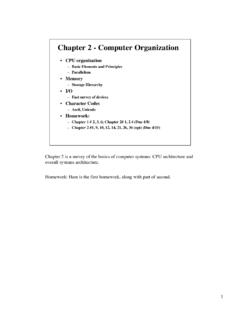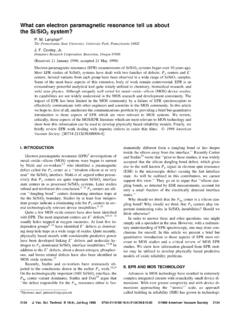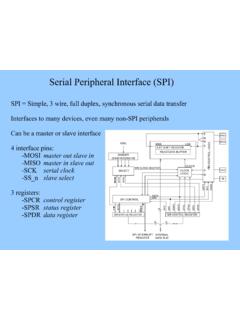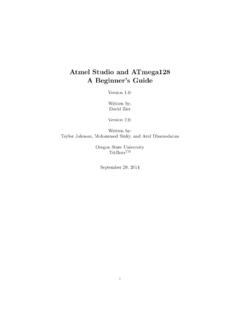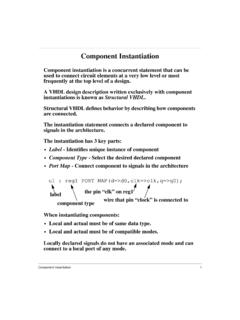Transcription of SECTION 5: BLOCK DIAGRAMS - College of Engineering
1 SECTION 5: BLOCK . DIAGRAMS . ESE 499 Feedback Control Systems 2 BLOCK Diagram Manipulation K. Webb ESE 499. BLOCK DIAGRAMS 3. In the introductory SECTION we saw examples of BLOCK DIAGRAMS to represent systems, : BLOCK DIAGRAMS consist of Blocks these represent subsystems typically modeled by, and labeled with, a transfer function Signals inputs and outputs of blocks signal direction indicated by arrows could be voltage, velocity, force, etc. Summing junctions points were signals are algebraically summed . subtraction indicated by a negative sign near where the signal joins the summing junction K.
2 Webb ESE 499. Standard BLOCK Diagram Forms 4. The basic input/output relationship for a single BLOCK is: = . BLOCK diagram blocks can be connected in three basic forms: Cascade Parallel Feedback We'll next look at each of these forms and derive a single- BLOCK equivalent for each K. Webb ESE 499. Cascade Form 5. Blocks connected in cascade: 1 = 1 , 2 = 1 2 . = 2 3 = 1 2 3 . = 1 2 3 = . = 1 2 3 . The equivalent transfer function of cascaded blocks is the product of the individual transfer functions K. Webb ESE 499. Parallel Form 6. Blocks connected in parallel: 1 = 1 . 2 = 2 . 3 = 3 . = 1 2 3.
3 = 1 2 3 . = 1 2 3 = . = 1 2 3 . The equivalent transfer function is the sum of the individual transfer functions: K. Webb ESE 499. Feedback Form 7. Of obvious interest to us, is the feedback form: = . = . = . 1 + = .. = . 1 + . The closed-loop transfer function, , is . = =. 1 + . K. Webb ESE 499. Feedback Form 8.. =. 1 + . Note that this is negative feedback, for positive feedback: . =. 1 . The factor in the denominator is the loop gain or open-loop transfer function The gain from input to output with the feedback path broken is the forward path gain here, . In general: forward path gain =.
4 1 loop gain K. Webb ESE 499. Closed-Loop transfer Function - Example 9. Calculate the closed-loop transfer function and are in cascade 1 is in cascade with the feedback system consisting of , , and 2 .. = 1 . 1 + 2 . 1 . =. 1 + 2 . K. Webb ESE 499. Unity-Feedback Systems 10. We're often interested in unity-feedback systems Feedback path gain is unity Can always reconfigure a system to unity-feedback form Closed-loop transfer function is: . =. 1 + . K. Webb ESE 499. BLOCK Diagram Algebra 11. Often want to simplify BLOCK DIAGRAMS into simpler, recognizable forms To determine the equivalent transfer function Simplify to instances of the three standard forms, then simplify those forms Move blocks around relative to summing junctions and pickoff points simplify to a standard form Move blocks forward/backward past summing junctions Move blocks forward/backward past pickoff points K.
5 Webb ESE 499. Moving Blocks Back Past a Summing Junction 12. The following two BLOCK DIAGRAMS are equivalent: = 1 + 2 = 1 + 2 . K. Webb ESE 499. Moving Blocks Forward Past a Summing Junction 13. The following two BLOCK DIAGRAMS are equivalent: 1. = 1 + 2 = 1 + 2 .. K. Webb ESE 499. Moving Blocks Relative to Pickoff Points 14. We can move blocks backward past pickoff points: And, we can move them forward past pickoff points: K. Webb ESE 499. BLOCK Diagram Simplification Example 1. 15. Rearrange the following into a unity-feedback system Move the feedback BLOCK , , forward, past the summing junction Add an inverse BLOCK on to compensate for the move Closed-loop transfer function: 1.
6 = =. 1 + 1 + . K. Webb ESE 499. BLOCK Diagram Simplification Example 2. 16. Find the closed-loop transfer function of the following system through BLOCK -diagram simplification K. Webb ESE 499. BLOCK Diagram Simplification Example 2. 17. 1 and 1 are in feedback form 1 . =. 1 1 1 . K. Webb ESE 499. BLOCK Diagram Simplification Example 2. 18. Move 2 backward past the pickoff point BLOCK from previous step, 2 , and 2 become a feedback system that can be simplified K. Webb ESE 499. BLOCK Diagram Simplification Example 2. 19. Simplify the feedback subsystem Note that we've dropped the function of notation, , for clarity 1 2.
7 1 1 1 1 2. = =. 1 2 2 1 1 1 + 1 2 2. 1+. 1 1 1. K. Webb ESE 499. BLOCK Diagram Simplification Example 2. 20. Simplify the two parallel subsystems 4. = 3 +. 2. K. Webb ESE 499. BLOCK Diagram Simplification Example 2. 21. Now left with two cascaded subsystems transfer functions multiply 1 2 3 + 1 4. =. 1 1 1 + 1 2 2. K. Webb ESE 499. BLOCK Diagram Simplification Example 2. 22. The equivalent, close-loop transfer function is 1 2 3 + 1 4. =. 1 1 1 + 1 2 2. K. Webb ESE 499. 23 Multiple-Input Systems K. Webb ESE 499. Multiple Input Systems 24. Systems often have more than one input , reference, , and disturbance.
8 Two transfer functions: From reference to output = . From disturbance to output = / . K. Webb ESE 499. transfer Function Reference 25. Find transfer function from to . A linear system superposition applies Set = 0.. = =. 1 + . K. Webb ESE 499. transfer Function Reference 26. Next, find transfer function from to . Set = 0. system now becomes: . = =. 1 + . K. Webb ESE 499. Multiple Input Systems 27. Two inputs, two transfer functions . =. 1+ . and =. 1+ . is the controller transfer function Ultimately, we'll determine this We have control over both and . What do we want these to be? Design for desired performance Design for disturbance rejection K.
9 Webb ESE 499. 28 Preview of Controller Design K. Webb ESE 499. Controller Design Preview 29. We now have the tools necessary to determine the transfer function of closed-loop feedback systems Let's take a closer look at how feedback can help us achieve a desired response Just a preview this is the objective of the whole course Consider a simple first-order system . A single real pole at = 2.. K. Webb ESE 499. Open-Loop Step Response 30. This system exhibits the expected first- order step response No overshoot or ringing K. Webb ESE 499. Add Feedback 31. Now let's enclose the system in a feedback loop Add controller BLOCK with transfer function.
10 Closed-loop transfer function becomes: 1.. = + 2 =. 1. 1 + + 2 + 2 + . Clearly the addition of feedback and the controller changes the transfer function but how? Let's consider a couple of example cases for . K. Webb ESE 499. Add Feedback 32. First, consider a simple gain BLOCK for the controller Error signal, , amplified by a constant gain, . A proportional controller, with gain . Now, the closed-loop transfer function is: . + 2 . = =.. 1 + + 2 + 2 + . A single real pole at = 2 + . Pole moved to a higher frequency A faster response K. Webb ESE 499. Open-Loop Step Response 33. As feedback gain increases: Pole moves to a higher frequency Response gets faster K.
